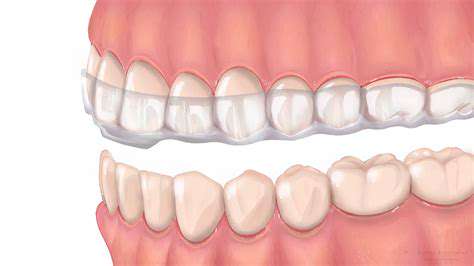How Dental Splints Can Transform Your Oral Health

Finding Relief from Jaw Pain with Custom Splints
Custom dental appliances, professionally known as occlusal splints or mouthguards, are precisely molded to fit individual dental arches. These therapeutic devices create a protective buffer between teeth surfaces, effectively absorbing shock and redistributing forces across the jaw structure. Clinical observations confirm that properly fitted splints serve as an essential tool for controlling involuntary jaw movements, particularly in cases of nocturnal bruxism and TMJ dysfunction. The physical barrier they provide prevents enamel erosion and reduces mechanical stress on vulnerable dental work.
Numerous clinical reports demonstrate measurable reductions in chronic orofacial pain, tension headaches, and referred ear discomfort following splint therapy. This therapeutic effect stems from interrupting the cycle of muscular hyperactivity, allowing inflamed tissues to recover while maintaining proper jaw alignment during rest periods.
Optimizing Bite Function and Structural Integrity
Modern occlusal splints do more than just protect teeth - they actively improve dental occlusion. By establishing an ideal contact plane between arches, these devices help redistribute masticatory forces more evenly across the dental quadrants. This biomechanical advantage proves particularly valuable for patients with uneven wear patterns or compromised dental work.
The long-term protective benefits extend beyond immediate symptom relief. Consistent splint use prevents the cumulative damage caused by parafunctional habits, preserving tooth structure and supporting periodontal health. Many dental professionals consider them an essential component of comprehensive oral rehabilitation plans.
Addressing Complex TMJ Dysfunction
Temporomandibular joint disorders present complex diagnostic and treatment challenges. Therapeutic splints serve as a first-line intervention by modifying joint loading patterns and reducing inflammatory responses. The devices work through multiple mechanisms - they decrease compressive forces on articular surfaces while simultaneously retraining neuromuscular patterns.
Clinical outcomes often show improved mandibular range of motion and decreased joint noise after several months of compliant splint use. For many patients, this non-invasive approach provides sufficient relief to avoid more aggressive treatments like joint injections or surgical interventions.
Combating Destructive Bruxism Patterns
Sleep-related bruxism affects approximately 8-10% of adults, often causing progressive dental damage before patients become aware of the problem. Occlusal splints serve as both diagnostic tools and protective measures in these cases. The wear patterns that develop on the splint surface provide valuable clinical information about the intensity and frequency of grinding episodes.
Beyond protection, some evidence suggests splints may help reduce bruxism frequency through proprioceptive feedback mechanisms. Patients who consistently use their appliances often report secondary benefits including improved sleep quality and decreased morning jaw stiffness.
The Science Behind Splints and Headache Relief
Biomechanical Influences on Cranial Pain
Current research continues to explore the complex relationship between dental occlusion and headache pathophysiology. While the exact mechanisms remain under investigation, clinical evidence supports the hypothesis that properly adjusted splints can reduce trigeminal nerve irritation and associated pain referral patterns. This neurophysiological effect may explain why some patients experience headache relief even before structural changes become apparent.
Emerging theories suggest splints may influence pain processing through multiple pathways, including modulation of muscle spindle activity and alteration of cortical sensory mapping. These central nervous system effects could account for the variable response patterns observed in clinical practice.
Identifying Headache Types Amenable to Splint Therapy
Not all headaches respond equally to occlusal interventions. The most promising candidates include tension-type headaches with clear temporal relationship to jaw function, as well as certain secondary headaches with documented TMJ involvement. Interestingly, some migraine sufferers report decreased attack frequency with splint use, particularly those with identifiable jaw-related triggers.
Accurate diagnosis remains paramount - dental professionals must carefully differentiate between primary headaches and those with dental etiologies. Multidisciplinary evaluation often proves necessary to identify appropriate candidates for occlusal therapy.
Evaluating the Clinical Evidence Base
While numerous case studies support splint efficacy, larger controlled trials present mixed results. This discrepancy likely reflects variations in splint design, patient selection criteria, and outcome measurement protocols. The most consistent positive outcomes appear in studies focusing on well-defined TMJ-related pain conditions rather than primary headache disorders.
Practical Considerations in Therapeutic Application
Several practical factors influence splint effectiveness for headache management. Treatment timing proves critical - early intervention during acute phases often yields better outcomes than delayed treatment. Material selection also matters, with harder acrylic splints generally providing more predictable results for pain management than softer alternatives.
The Critical Importance of Precision Fabrication
Successful splint therapy requires meticulous attention to occlusal details. Even minor discrepancies in vertical dimension or guidance angles can exacerbate symptoms rather than alleviate them. Modern digital workflows now allow for unprecedented precision in splint fabrication, though clinical expertise remains essential for proper adjustment and follow-up care.
Integrating Dental and Medical Perspectives
Effective headache management often requires collaboration between dental and medical professionals. Dentists contribute specialized knowledge of craniofacial anatomy and occlusion, while physicians provide broader neurological perspective. This team approach maximizes diagnostic accuracy and therapeutic outcomes for patients with complex pain presentations.
Optimizing Patient Engagement and Outcomes
Therapeutic success depends heavily on patient understanding and cooperation. Comprehensive education about realistic expectations, proper usage protocols, and potential adjustment periods improves compliance rates. Regular follow-up appointments allow for necessary modifications and reinforce the importance of consistent splint use.